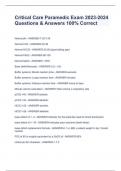Critical Care Paramedic Exam 2023-2024
Questions & Answers 100% Correct
Normal pH - ANSWER-7.35-7.45
Normal CO2 - ANSWER-35-45
Normal HCO3 - ANSWER-22-26 (good dating age)
Normal PaO2 - ANSWER-80-100
Normal SaO2 - ANSWER-> 95%
Base (deficit/excess) - ANSWER-(-2) - (+2)
Buffer systems: Bicarb reaction time - ANSWER-seconds
Buffer systems: Lungs reaction time - ANSWER-minutes
Buffer systems: Kidneys reaction time - ANSWER-hours to days
Minute volume calculation - ANSWER-Tidal volume x respiratory rate
pCO2 >45 - ANSWER-acidotic
pCO2 <35 - ANSWER-alkalotic
HCO3 <22 - ANSWER-acidotic
HCO3 >26 - ANSWER-alkalotic
base deficit of < -4 - ANSWER-indicator for the potential need for blood transfusion
base deficit of < -19 - ANSWER-indicates poor outcome (death likely)
base deficit replacement formula - ANSWER-0.1 x (-BE) x patient weight in kg = bicarb
needed
PO2 of 60 is roughly equivalent to a SaO2 of - ANSWER-90%
critical pH for intubation - ANSWER-< 7.2
,critical pCO2 for intubation - ANSWER-> 55
critical pO2 for intubation - ANSWER-< 60
number one cause of metabolic acidosis - ANSWER-lactic acidosis (lactate > 4)
CO2 is a byproduct of - ANSWER-metabolism
for every __ change in ETCO2, you should expect the pH to change __ in the
___________ direction. - ANSWER-10, 0.08, opposite
for every __ change in pH, you should expect the HCO3 to change __ in the
___________ direction. - ANSWER-0.15, 10, same
for every __ change in pH, you should expect the potassium to change __ in the
___________ direction. - ANSWER-0.10, 0.6, opposite
LEMON - ANSWER-difficult intubation
look, evaluate (3-3-2), mallampati, obstructions, neck mobility
HEAVEN - ANSWER-difficult intubation
Hypoxia, extremes of size, anatomic challenges, vomit/blood/fluid, exsanguination, neck
mobility issues
ramping - ANSWER-ear to sternal notch
without ramping during intubation or transport causes a potential for - ANSWER-
decrease in functional reserve capacity, tidal volume, and preload
Sellick's maneuver and BURP - ANSWER-no longer recommended
External laryngeal manipulation (ELM) - ANSWER-current standard of practice
bougie adult size - ANSWER-15 Fr
bougie pediatric size - ANSWER-10 Fr
bougie neonatal size - ANSWER-6 Fr
supraglottic devices - ANSWER-provide little protection against aspiration
ETT cuff pressure - ANSWER-20-30 mmHg (25 is standard)
gold standard of confirming ET placement - ANSWER-chest X-Ray
,distal tip of ET - ANSWER-2-3 cm (1 inch) above carina, at T3 or T4
7 p's for RSI success - ANSWER-preparation, preoxygenation, pretreatment, paralysis
with induction, protect/position, placement (with proof), post intubation management
LOAD - ANSWER-pretreatment for RSI
lidocaine, opiates, atropine (infants), defasiculating dose
fentanyl adult dose - ANSWER-1 mcg/kg
fentanyl onset - ANSWER-3-5 mins
fentanyl post intubation management - ANSWER-0.5 - 1.5 mcg/kg every 5 minutes
fentanyl post intubation management infusion - ANSWER-1-3 mcg/kg/hour
fentanyl reversal agent - ANSWER-narcan
etomidate adult dose - ANSWER-0.3 mg/kg
etomidate onset time - ANSWER-15-45 seconds
etomidate duration - ANSWER-3-12 minutes
etomidate cautions/contraindications - ANSWER-hemodynamically unstable patients,
adrenal suppression, shock patients, COPD/asthmatic
ketamine adult dose - ANSWER-1-2 mg/kg
ketamine onset - ANSWER-40-60 seconds
ketamine duration - ANSWER-10-20 minutes
ketamine is preferred for - ANSWER-asthmatic patients
ketamine post intubation management - ANSWER-0.5 - 1 mg/kg
ketamine post intubation management infusion - ANSWER-1-2 mg/kg/hour
versed adult dose - ANSWER-2.5-5 mg
versed onset - ANSWER-30-60 seconds
versed duration - ANSWER-15-30 minute duration
versed post intubation management - ANSWER-2-5 mg
, versed post intubation management infusion - ANSWER-0.05 - 0.1 mg/kg/hour
versed reversal agent - ANSWER-flumazenil (romazicon) 0.2 mg
propofol (diprivan) adult RSI dose - ANSWER-1-2 mg/kg
propofol (diprivan) adult maintenance dose - ANSWER-25-50 mcg/kg/min
propofol (diprivan) onset - ANSWER-15-45 seconds
propofol (diprivan) duration - ANSWER-5-10 minutes
propofol (diprivan) cautions - ANSWER-hemodynamically unstable patients
succinylcholine (anectine) - ANSWER-depolarizing neuromuscular blocker agent
succinylcholine (anectine) can cause - ANSWER-fasciculations
hyperkalemia
succinylcholine (anectine) requires - ANSWER-refrigeration
succinylcholine (anectine) contraindications - ANSWER-crush injuries, eye injuries,
narrow-angle glaucoma, malignant hyperthermia, burns >24 hours old, hyperkalemia,
Guillain- Barre, Myasthenia gravis
succinylcholine (anectine) adult dose - ANSWER-1-2 mg/kg (max 150)
succinylcholine (anectine) onset - ANSWER-< 1 minute
succinylcholine (anectine) duration - ANSWER-4-6 minute duration
malignant hyperthermia - ANSWER-rapid body temperature increase and increased
ETCO2
malignant hyperthermia treatment - ANSWER-Dantrolene Sodium (Dantrium) 2.5 mg/kg
rapid
Rocuronium (Zemeron) - ANSWER-non-depolarizing neuromuscular blocking agent
Rocuronium (Zemeron) adult RSI dose - ANSWER-0.6 - 1.2 mg/kg
Rocuronium (Zemeron) maintainance dose - ANSWER-0.1 - 0.2 mg/kg every 20-30
minutes
Rocuronium (Zemeron) onset - ANSWER-< 2 minutes




